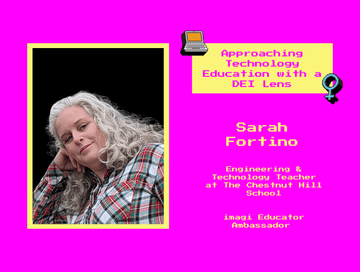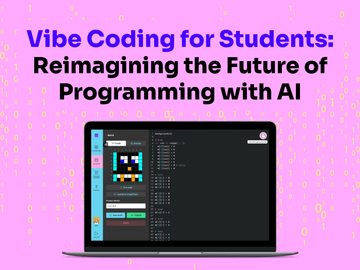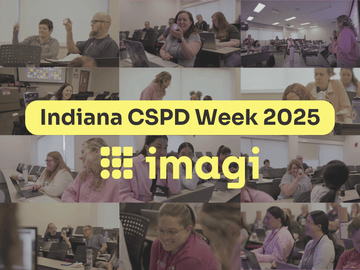
Sarah Fortino, an engineering and technology teacher at The Chestnut Hill School, in Chestnut Hill, Massachusetts, is rethinking the way technology education is taught. Through her cross-disciplinary units which build technology, design, and research skills, she gives students opportunities to learn about underrepresented leaders in the field of STEM and build real-world connections.
In honor of Women’s History Month, we’re delighted to be able to shine a spotlight on extraordinary educators in our community who are doing amazing work to ensure that students can learn about diverse role models in STEM - not only during special months like Black History or Women’s History Month, but throughout the year. For the past three years, Sarah Fortino has been leading an exciting seven-week biographical unit for her 5th Grade students. Throughout seven weeks, students build critical research, design and technology skills, all while getting to learn about inspiring women whose stories are often left out of traditional history books and curriculums. Her last unit focused on “Black Women in STEM in the US,” and she’s currently doing research for next year's unit, which will be focused on “Indigenous Women in STEM.” We hope reading about her process and the impact this project has on her students will inspire you as much as it did us!
Technology Education across Subject Areas
To begin each unit, Sarah starts by researching the topic herself. For her most recent project, she leveraged the book Changing the Equation: 50+ US Black Women in STEM by Tonya Bolden in order to then provide her students with a diverse range of women to choose from for their research projects. Before diving into biographical research for a specific woman in STEM, Sarah introduces the concept and allows her students to practice by sharing biographical information of themselves in an Instagram-sized graphic created on Canva. Sarah shares that she wishes she had had more opportunities to be exposed to great technology and design tools as a student, so it’s very important to her to give these opportunities to her own students.
Building Students’ Design, Research, and Communication Skills
Once they have completed their personal biography projects on Canva, Sarah’s students get to select a woman to research and leverage a variety of great resources to gather information. They use safe search tools for students like SweetSearch and Kiddle and then learn about the importance of cross checking information.
After completing their research, students create five different designs on Canva to reflect their research. Sarah also incorporates a peer feedback session where students can give and receive feedback from one another and from her. They get to make the choice to take or leave the feedback and then print their favorite final design. Check out just a few of the final projects from her students below!

The Importance of “Mirrors and Windows” in the Technology Classroom
For Sarah, this project has had a profound impact on both the girls and boys in her classroom. “It‘s eye opening for them to see the struggles of these women,” she says. She also shares how important it was for this project to provide a mirror for some students to see themselves in these women, and a window for others, which alludes to the important analogy of Mirrors, Windows, and Sliding Glass Doors provided by the Rudine Sims Bishop, an esteemed professor, researcher, and advocate for multicultural children’s education. As Sarah explains, for many of her students, this may have been the first time they were seeing someone who looked like them represented in STEM. For the boys, she felt it was equally important that they were exposed to strong, brave, representations of women in the world.
From Real-World STEM Role Models to Coding with imagi
Sarah also has noticed her women in STEM unit is an excellent way to help students make real-world connections which can extend beyond the classroom. After getting to see how real people made concrete changes in the world in their respective STEM fields, Sarah feels like her students are amply prepared for the unit she does next on Python coding with imagi. They’ve already seen how design and technology are closely connected, so creating pixel art through coding with Python is a natural next step. It’s no surprise that her students' work with imagi is equally as impressive as her student’s projects on women in STEM. We can’t wait to see what they’ll create, design, and code next!

Inspired by Sarah and her students’ work? You can begin a unit on pixel art and coding with your students today using imagi Edu!
About Sarah Fortino
Sarah Fortino has been teaching engineering, robotics, and technology to students aged three through grade nine for well over a decade, her teaching career has taken her to several different countries. She has been at the Chestnut Hill School since the fall of 2014 teaching computer science, engineering, and technology to kids aged 3 to 12. Sarah worked at the Boston Science Museum as a Teacher in Residence during the summer of 2017, focusing on Computer Science. She has an M.Ed. in Elementary Education & Instruction from UMass Boston and a Bachelor's Degree in Photographic Electronic Imaging with a concentration in Computer Animation from UMass Dartmouth. Follow her on Instagram at @edtechbitsandbytes to see what cool project she’ll be working on next.




